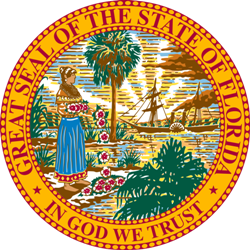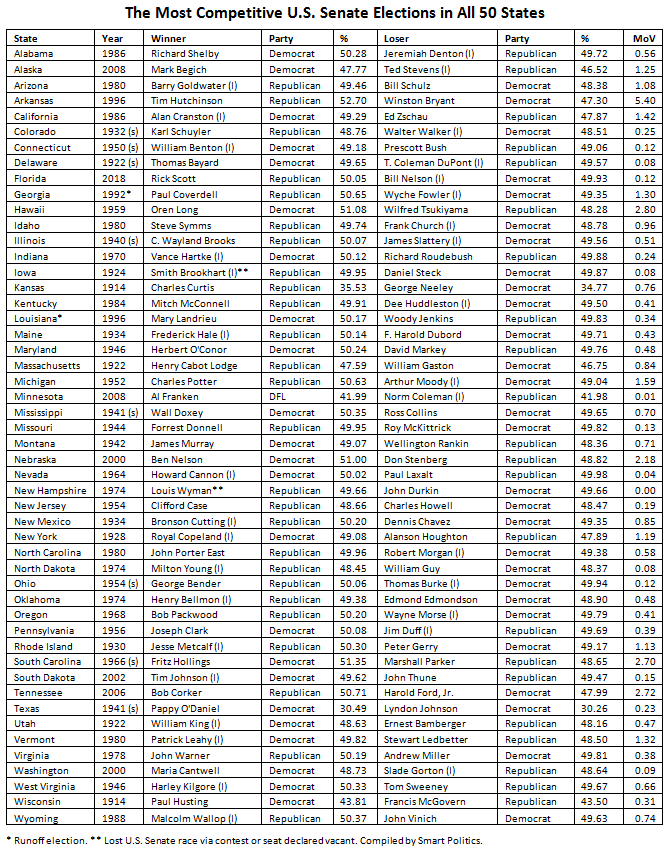Florida 2018 and the Closest US Senate Races In the 50 States
The Scott vs Nelson contest broke a 30-year record for the most competitive election for the office in state history

With the recount in Florida’s race now complete, the 0.12-point victory by Republican Governor Rick Scott over three-term Senator Bill Nelson became not only the most narrowly-decided race of the election cycle, but also the closest U.S. Senate race out of the 38 conducted in Sunshine State history.
The high-profile election breaks the mark previously set in 1988 when three-term GOP U.S. Representative Connie Mack III defeated three-term Democratic Congressman Buddy MacKay by 0.85 points (50.42 percent to 49.57 percent).
And it also joins the 2004 contest between Republican HUD Secretary Mel Martinez and former state Education Secretary Betty Castor as the second time in state history in which Florida has hosted the nation’s most competitive U.S. Senate election of the cycle. That race was decided by 1.1 points in favor of Martinez.
Only Indiana with four (1916, 1926, 1938, 1970) and Nevada (1914, 1964, 1998) and Virginia (1978, 2006, 2014) with three have tallied more. Fourteen other states have also hosted the cycle’s closest race two times: Colorado, Connecticut, Delaware, Idaho, Illinois, Kentucky, Maine, Minnesota, Missouri, New Hampshire, New York, North Dakota, Ohio, and South Dakota
In addition to the 1988, 2004, and 2018 contests, only three other Florida U.S. Senate races were decided by less than five points in the direct election era:
- 1974: Democratic Florida Secretary of State Richard Stone by 2.5 points over non-profit executive Jack Eckerd
- 1980: Republican Public Service Commissioner Paula Hawkins by 3.3 points over state Treasurer Bill Gunter
- 2000: Then Treasurer Bill Nelson by 4.9 points over Congressman Bill McCollum
Florida’s 2018 contest was the only U.S. Senate election to set a new state record this cycle – and the only race to be decided by less than a percentage point.
Elections for the office in four other states had victory margins of less than five points: Arizona (2.4 points), Texas (2.6), West Virginia (3.3), and Montana (3.6). [Pending the result of the upcoming run-off in Mississippi’s special election].
Adding in the 2018 results, at least one U.S. Senate race has been decided by less than a point during 10 of the last 12 election cycles since 1996 (all but 2004 and 2010).
Most states have enjoyed at least one extremely competitive U.S. Senate election over the last century, with 37 states hosting at least one election decided by less than one percentage point.
Smart Politics reviewed the nearly 1,800 direct elections that have been conducted for the U.S. Senate to determine the most closely decided contests in each of the 50 states.
The most narrowly decided races in seven states ended up with victory margins tallying less than one-tenth of a percentage point.
- New Hampshire, 1974 (0.00 points): Republican Louis Wyman over Democrat John Durkin. This election was famously ‘decided’ by just two votes (in favor of Wyman, according to the Republican ballot commission) and then 10 votes (in favor of Durkin, according to the Secretary of State) out of more than 223K votes cast. Democrats could not overcome a GOP filibuster to seat Durkin, however, and a new election was held more than 10 months later in September 1975 with Durkin victorious by 10.6 points.
- Minnesota, 2008 (0.01 points): DFLer Al Franken defeated one-term Republican U.S. Senator Norm Coleman after a protracted recount and lawsuit. Franken was eventually seated in July 2009 with a 225-vote victory out of nearly 2.9 million votes cast.
- Nevada, 1964 (0.04 points): One-term Democratic U.S. Senator Howard Cannon edged Republican Lieutenant Governor Paul Laxalt by 48 votes out of more than 134K votes.
- Delaware, 1922 special (0.08 points): Democratic attorney Thomas Bayard defeated appointed U.S. Senator T. Coleman DuPont by 60 votes out of 74K+ votes cast. Bayard also simultaneously defeated DuPont by 0.43 points in the election to the seat for the unexpired six-year term.
- Iowa, 1924 (0.08 points): One-term Republican U.S. Senator Smith Brookhart edged Democratic attorney Daniel Steck by 755 votes out of 896K+ votes cast. However, Steck later successfully contested the election and was seated in April 1926.
- North Dakota, 1974 (0.08 points): Five-term Republican U.S. Senator Milton Young defeated former Democratic Governor William Guy by 177 votes out of 237K cast.
- Washington, 2000 (0.09 points): Former Democratic Congresswoman Maria Cantwell beat Republican U.S. Senator Slade Gorton by 2,229 votes out of 2.4+ million votes.
Of the remaining 13 states, the closest U.S. Senate race in five states resulted in victory margins of more than two points with Arkansas’ the largest in the nation at 5.4 points (Republican Tim Hutchinson over Democrat Winston Bryant in 1996).
Hawaii (1959, 2.80 points), Tennessee (2006, 2.72 points), South Carolina (1966, 2.70 points), and Nebraska (2000, 2.18 points) round out the bottom five.
Prior to Florida’s 2018 race, the last two state records to fall came during the 2008 cycle with voters in Alaska and the aforementioned race in Minnesota between Franken and Coleman treated to historically close finishes.
In Alaska, Democrat Mark Begich defeated seven-term Republican U.S. Senator Ted Stevens by 1.25 points besting a Last Frontier State mark set four years earlier when GOP U.S. Senator Lisa Murkowski beat former Governor Tony Knowles by 3.03 points in 2004.
In Minnesota, Franken’s 0.01-point win over Coleman ended an 84-year record dating back to the Election of 1924 when Republican Congressman Thomas Schall unseated Farmer-Laborite U.S. Senator Magnus Johnson by a 0.95-point margin.
Other state records set during the 21st Century came in Nebraska in 2000 (Democrat Ben Nelson by 2.18 points over Don Stenberg), Washington in 2000 (the previously discussed race between Cantwell and Gorton), South Dakota in 2002 (Democratic U.S. Senator Tim Johnson by 0.15 points over Republican U.S. Representative John Thune) and Tennessee in 2006 (Republican Bob Corker by 2.72 points over Democratic Congressman Harold Ford, Jr.).
Two states have not seen their records fall since the inaugural cycle in 1914 requiring direct elections after the passage of the 17th Amendment: Kansas (former Republican U.S. Senator Charles Curtis by 0.76 points over Democratic Congressman George Neeley) and Wisconsin (former Democratic state legislator Paul Husting by 0.31 points over Governor Francis McGovern).
Records in five other states have stood since the 1920s: Massachusetts (1922), Utah (1922), Delaware (1922), Iowa (1924), and New York (1928).
Follow Smart Politics on Twitter.


1. It ought to be noted that the GA/1992 and LA/1996 outcomes are those of the RUNOFFs between the 2 highest vote-getters, just as “special elections” (TX/1941, et.al.) and reversals and do-overs have been noted as such.
2. The SC/1966 between D Ernest Hollings and R Marshall Parker was a “special”, for the unexpired term of Olin DeWitt Talmadge Johnston (Hollings would stand for and win again in 1968 and every 6 years through 1998).
Details are now duly noted in the table above – thanks!
3. “…West Virginia (3.3%), and Montana (3.6%)”. Senator J Tester at last managed to out-perform fellow two-term colleague Joe Manchin, in addition to finally garnering a majority of the statewide vote. What is arguably even more impressive is that “Flattop Jon” achieved his win even as he opposed Jeff Sessions, Rex Tillerson, Neil Gorsuch, and Brett Kavanaugh confirmation votes, and generally has stood with his Caucus colleagues and his (national) party – something Manchin noticeably chose not to do.